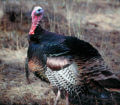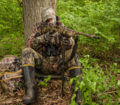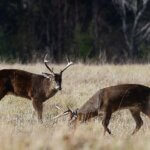John’s Note: Bucky Hauser of Virginia has been hunting turkeys for almost 3 decades. Here are some of his strategies to help us take turkeys this season.
* Don’t Let the Turkeys Smell You During Early Season Scouting for Turkeys:
 When turkey hunting, one thing many hunters completely overlook is controlling human odor. We all know that turkeys can’t smell like deer do. But turkeys aren’t the only animals in the woods during spring turkey season. Most places where you’ll discover turkeys you’ll also find deer. Every time I go hunting, I spray down with an odor eliminator, because animals other than turkeys can give alarm sounds. When they do, turkeys can hear and understand that the alarm sounds of other animals mean there’s danger in the woods. You may be set-up and working a turkey when a deer comes in downwind of you and starts blowing and stomping, because he smells your human odor. If the deer smells you, it will spook the turkey. I go one step farther than just using odor killer when I’m hunting for turkeys. I use odor killer when I’m scouting for turkeys too. I don’t want any animal in the woods to know that I’m a hunter. Therefore when I’m scouting, I wear full Mossy Oak camouflage, and I’m as scent-free as possible.
When turkey hunting, one thing many hunters completely overlook is controlling human odor. We all know that turkeys can’t smell like deer do. But turkeys aren’t the only animals in the woods during spring turkey season. Most places where you’ll discover turkeys you’ll also find deer. Every time I go hunting, I spray down with an odor eliminator, because animals other than turkeys can give alarm sounds. When they do, turkeys can hear and understand that the alarm sounds of other animals mean there’s danger in the woods. You may be set-up and working a turkey when a deer comes in downwind of you and starts blowing and stomping, because he smells your human odor. If the deer smells you, it will spook the turkey. I go one step farther than just using odor killer when I’m hunting for turkeys. I use odor killer when I’m scouting for turkeys too. I don’t want any animal in the woods to know that I’m a hunter. Therefore when I’m scouting, I wear full Mossy Oak camouflage, and I’m as scent-free as possible.
If you spot a turkey out on the edge of a field before turkey season, and a deer starts blowing, stomping his feet or running off, an older-age-class turkey will know that’s where danger has come into the woods. Regardless of the animal you’re hunting, you not only want to be invisible to his eyes by wearing Mossy Oak camo, you also want to be invisible to his nose. We really don’t know if odor control products kill odor, but we do know that they reduce the amount of odor a deer can smell. Possibly, even if a deer smells you, because the odor’s greatly reduced, the deer may think that several hours have passed since a human’s gone that way. If he smells you, he won’t be nearly as alarmed.
 So, don’t forget that turkeys aren’t the only critters in the outdoors during the spring. If you don’t eliminate human odor, you will spook other game, and that game can and will spook your turkey. You don’t want to spook a blue jay, a squirrel or even the morning birds that get up before the turkey does. The only difference in scouting before the season and hunting during the season is you don’t have a gun in your hand when you’re scouting before the season. Always remember to scout as stealthily, quietly, odor-free and camouflaged as you do during hunting season. Then, you’ll see more turkeys and spook fewer turkeys.
So, don’t forget that turkeys aren’t the only critters in the outdoors during the spring. If you don’t eliminate human odor, you will spook other game, and that game can and will spook your turkey. You don’t want to spook a blue jay, a squirrel or even the morning birds that get up before the turkey does. The only difference in scouting before the season and hunting during the season is you don’t have a gun in your hand when you’re scouting before the season. Always remember to scout as stealthily, quietly, odor-free and camouflaged as you do during hunting season. Then, you’ll see more turkeys and spook fewer turkeys.
* Don’t Move When You’re Hunting Turkeys:
Many hunters don’t realize how still you have to be when you’re turkey hunting. Most hunters don’t consider where the turkey’s eyes are located on its head. A turkey’s eyes are on the sides of his head – not on the front of his head like our eyes. We can see straight ahead, but we don’t have very-good peripheral vision. A turkey has 180-degree eyesight in each of his eyes and can spot the slightest bit of movement off to the side of him, as well as in front of him. If you’ve noticed, when a turkey really starts looking at something, he’ll cock his head to the side and more or less look to one side. Then he’ll turn his head the other way and look with the other eye, so he can see everything all the way around him, to pick up any movement that is within his vision.
If you’re a fisherman, you know that sonar has changed dramatically. Our depth finders used to show us what was directly underneath our boats. If you passed by something just out of the cone angle of your depth finder, you couldn’t see it. However, with the new side-scanning depth finders, you can see not only down, but everything on the left and the right sides of the boat. And, that’s the difference in a hunter’s eyesight and a turkey’s eyesight. The hunter can see what’s in front of him. The gobbler can see everything around him, and that’s the reason you have to keep your movement to a minimum and wear camouflage.
The turkey knows that there are thermals and different types of winds in the outdoors. It understands that sometimes the wind will blow in one area of the woods but not in another section. The bird realizes that if a strong wind is blowing, then all the bushes and trees will be moving at the same time. But if there’s only a slight breeze, some bushes may move, but others may not. If you’re wearing full Mossy Oak camouflage, you can get away with some movement.
 During the spring, I wear two different patterns – Mossy Oak Break-Up Infinity (http://www.mossyoak.com/camouflage/breakupinfinity.aspx) and Mossy Oak Obsession (http://www.mossyoak.com/camouflage/obsession.aspx). Break-Up Infinity has the darker colors, and Obsession features the greener colors. At the first of turkey season in my home state of Virginia, the woods aren’t fully green. Most of the woods still have those darker tones like you see in Mossy Oak Break-Up. So, I wear Break-Up the first 2 weeks of the season. Then as the woods become greener, I wear Mossy Oak Obsession.
During the spring, I wear two different patterns – Mossy Oak Break-Up Infinity (http://www.mossyoak.com/camouflage/breakupinfinity.aspx) and Mossy Oak Obsession (http://www.mossyoak.com/camouflage/obsession.aspx). Break-Up Infinity has the darker colors, and Obsession features the greener colors. At the first of turkey season in my home state of Virginia, the woods aren’t fully green. Most of the woods still have those darker tones like you see in Mossy Oak Break-Up. So, I wear Break-Up the first 2 weeks of the season. Then as the woods become greener, I wear Mossy Oak Obsession.
For me, camouflage needs to match the woods at the time of the year and the area where I’m hunting. Break-Up is a more-open pattern and has more of the blacks, browns and grays in it. I don’t think you can beat this pattern for early-season turkey hunting. Obsession has more of the greens and blends in better as the woods become greener. I’m convinced that matching the colors of my camo to the colors the turkey is seeing in the woods helps me to stay hidden better. I know that different hunters have various ideas about camouflage, and some hunters will wear the same camo pattern during the entire season. But with these two patterns, I successfully can hunt early and late turkey season.
To learn more about turkey hunting, check out John E. Phillips’ print, Audible, Kindle and Nook turkey books at https://johninthewild.com/books/#turkey and at www.barnesandnoble.com. You also can download a free Kindle app that enables you to read the book on your iPad, computer or SmartPhone. You can learn more about calling turkeys by going to johninthewild.com/audio-files/ for audio turkey tapes to purchase of Lovett Williams, Rob Keck and Chris Kirby, available for download to your SmartPhone, tablet or computer. For a free copy of John E. Phillips’ “The Turkey Gobbler Getter Manual,” go to https://johninthewild.com/free-books/ to download.
















